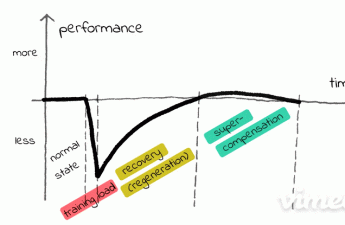The term “supercompensation” is familiar to most athletes. But what exactly is supercompensation? And does this concept have any right to exist at all?
What is supercompensation?
After a set training stimulus, the body regenerates the stressed muscles in order to repair them. It often overshoots the initial level and regenerates “too much”. And in most cases this is exactly what supercompensation means: the phase in which the body is in this so-called excessive recovery.
The original understanding of supercompensation
Today, this concept of supercompensation is applied to many areas. It was originally associated only with increased energy storage capacity within muscles and liver. According to current knowledge, this occurs as follows: At the beginning there is the stress stimulus in the course of training. This is followed by a phase in which the energy reserves decrease. The body then wants to compensate for this decrease, whereupon the energy reserves increase again during regeneration after training. In doing so, the body overshoots the target and reaches the phase of maximum energy storage – what the phase of this supercompensation means. If there is no new training stimulus at this point, the starting level is reached again. However, if one exposes oneself to a renewed load during supercompensation, this could result in an increase of performance.
Today’s understanding of supercompensation
So far about what was originally understood by the term supercompensation. Today, however, this spectrum seems to have become much wider: from improvements in nervous control processes to improvements in one’s own elasticity. Often it even seems as if the term would be regarded as a synonym for “improvement” in the most different areas.
Points of criticism
But even if we are definitely talking about the same facts: the concept of supercompensation has to take some criticism. Not only the lack of complexity, which would not adequately match physical adaptation processes, but also the fact that age and gender are just as disregarded as the training level of the athletes is criticized. Also, the endless possibilities of adaptation suggested in the model are not a realistic idea.
What does this mean for workout planning?
It seems that many people talk about supercompensation and only very few think about the same phenomenon. And this seems to be where the experts disagree: Does supercompensation exist, or not? It is not surprising that there are very controversial views on this. At least when you consider how many different physical adaptation processes this one term can refer to in everyday use. So, as in many areas of life, it is important not to blindly trust that using the same term actually means the same facts.
Even if the experts disagree, there seems to be agreement on one point: Regeneration and recovery are important. First, because muscles grow at rest and not during exercise. And secondly, because too frequent training may result in overtraining, which can lead not only to injury but also to a decrease in performance.



